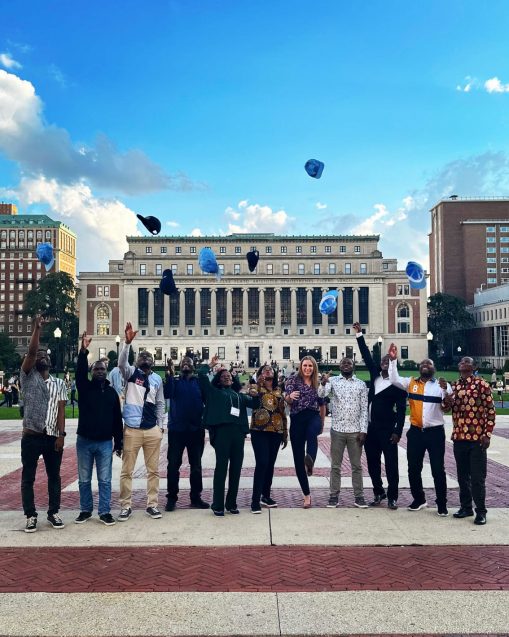Celebrating Women in Science: Amanda Grossi on Advancing Food Security
Adapted from a story written by Olga Rukovets for the State of the Planet news site.
As a Las Vegas native, Amanda Grossi grew up surrounded by more than just casinos. “It’s a very ecologically interesting place and close to some amazing geologic and natural wonders—canyons, wetlands, mountains and forests,” Grossi says. These unique landscapes, as well as the extreme heat she experienced, encouraged Grossi’s curiosity and passion for science from an early age.
Grossi is currently a senior staff associate at Columbia Climate School’s International Research Institute for Climate and Society (IRI), and manages IRI’s country-level activities in Ethiopia, Kenya, Zambia, Senegal, Ghana and Mali. Below, she talks about her inspiration, work initiatives and hopes for the next generation of women in science.

How did you get into science?
My last name means “well-fed” or “likes to eat” in Italian, I was born on World Food Day, and I love food and making sure everyone gets enough of it. Perhaps it was destiny that I would work with food and toward advancing food security.
I don’t remember a specific moment in time when I “got into science.” Rather, I would say science got into me. Anybody who is curious about the world, asks why things are the way they are, and systematically seeks to understand these things has science in their heart.
I was born in Las Vegas, Nevada, which many people may not realize is in a valley surrounded by old volcanoes, and despite being a desert was once entirely submerged by water millions of years ago. It’s also a very hot place that can reach 120 or 125 °F in the summer. When you’re melting away, it’s easy to wonder “why me?” but also just “why?”
I remember being so interested watching the weatherman on the nightly news explain how the Sierra Nevada mountains were stealing my city’s rain, why temperatures were so high or so low and that we could predict these things.
As I got older, learned more and travelled more widely, I also came to understand that for many people, access to this kind of information often means the difference between hunger and food security, whether a family can send children to school, and so much more.
How did this interest bring you to your current research?
Most of Africa relies on rainfed agriculture, and the forecast helps farmers—especially smallholder subsistence farmers—understand when and what to plant and how to grow their crops. Planting the wrong thing or planting at the wrong time, which unfortunately is becoming more common with increasingly erratic climate patterns, can mean a poor or even failed harvest.
This is one of the reasons I am proud to work with IRI. Innovative forecasting approaches coming out of our institute, and especially our NextGen forecasting approach based on more than 25 years of research at IRI, are helping farmers to plan for their seasons and decision-makers to better predict and plan for climate extremes like droughts and floods in more than 30 countries in Africa.
I am no longer a child watching this information flash across my television screen, but playing an active and catalytic role in ensuring those in countries whose livelihoods are most impacted by the climate challenge can access and use climate forecasts to improve their decision-making, livelihoods, income and lives.
“Beyond participation, we need young women and especially young women scientists in positions of leadership and mentorship.”
Is there a woman in science who inspired you?
Unequivocally, I am most inspired by Wangari Maathai, who was a Kenyan social, environmental and political activist, and the first African woman to receive the Nobel Peace Prize.
She was the first woman in East and Central Africa to earn a doctorate degree, and founded a visionary movement and organization called the Green Belt Movement, which focuses on planting trees, environmental conservation and women’s rights.
Even though Maathai was facing some of the most serious issues of her time, she moved people with her humor and grace to truly understand the global links between poverty and environmental degradation, and that communities and especially women could be a driving force at the center of conserving the environment and changing their own futures.
What really sticks with me about Maathai is her relentless determination to show people how important it is to connect the science to social action and education. I carry that simple but powerful idea with me every day.
In my current role at IRI, I spend most of my time trying to connect the best-available climate information and research to the people who need it most on the ground—especially farmers—through education and curriculum development.
We have worked with more than 70 institutions across Africa to co-develop curricula to help farmers manage climate risk. We are also working with higher education institutions to ensure that the next generation of humanitarian workers, policymakers, researchers and others are climate-literate and equipped with the knowledge skills to understand, analyze and communicate climate data and information to improve lives and livelihoods.

When I’m travelling with IRI in Senegal, Ghana, Zambia, Ethiopia and Kenya doing this work and feeling a little tired, I will often think of Maathai and how fearless and committed she was toward helping people understand how intertwined environmental and social issues are.
How can we continue to support and mentor women scientists?
We can continue to support and mentor women scientists by recognizing the importance not just of women in science but of young women in science.
By 2050, Africa will have 2.5 billion people, and 70% of those will be young people. If we are serious about equipping people in parts of the world most affected by climate variability and change to tackle these issues meaningfully and sustainably, young people will be at the center of those solutions.
Beyond participation, we need young women and especially young women scientists in positions of leadership and mentorship. Concretely, we can work toward ensuring young women have equal access to technical education and capacity-development opportunities. We can put systematic practices and policies in place to ensure they are connected to mentors who can provide guidance, advice and opportunities to develop themselves professionally and personally.
I want people to understand that supporting women scientists through intentional mentorship opportunities is not an extra step. It’s a missed step.
Meet some of the women scientists at Lamont-Doherty Earth Observatory in the video below; read about others from DEES, IRI and CIESIN; and learn how Columbia University is promoting women in science.

You must be logged in to post a comment.